Abstract
Experiments were conducted on anaesthetized, paralysed and artificially ventilated cats in order to determine if the altered discharge pattern of phrenic motoneurones recorded during stimulation of medullary raphe nuclei (raphe magnus (r. magnus), raphe obscurus (r. obscurus), raphe pallidus (r. pallidus] are related to release of serotonin (5-hydroxytryptamine, 5-HT) at synapses on respiratory neurones. Effects of 5-HT released by the neurotoxin p-chloroamphetamine (PCA) on spontaneous activity of phrenic motoneurones were also examined. In addition, responses of phrenic motoneurones to 5-HT applied by micro-electrophoresis were recorded. Stimulation (100 Hz) of r. magnus or r. obscurus depressed the spontaneous inspiratory discharges of phrenic motoneurones. Administration of the 5-HT receptor antagonists cinanserin, methysergide or methergoline reduced, but did not abolish, the inhibition. Inhibition of the neuronal reuptake of 5-HT with fluoxetine enhanced the inhibition and reduced the peak inspiratory action potential frequency of spontaneous discharges. Stimulation (100 Hz) of r. pallidus produced increased firing of phrenic motoneurones. Firing of phrenic motoneurones was evoked even during the normally quiescent expiratory phase of spontaneous respiratory activity. Antagonists at 5-HT receptors reduced the degree of tonic firing, resulting in partial restoration of expiratory pauses during r. pallidus stimulation. Inhibition of 5-HT reuptake, on the other hand, resulted in increased tonic firing. Release of 5-HT by PCA produced a rapid and severe reduction of phrenic nerve activity. Activity was restored by 5-HT receptor antagonists. In reserpine-treated cats, effects of stimulating medullary raphe nuclei were still pronounced, however 5-HT receptor antagonists had no effect on the responses. These results, along with the observation that 5-HT receptor antagonists are only partially effective in non-reserpinized cats, indicate that non-serotoninergic influences contribute as well to the responses evoked by raphe stimulation. Micro-electrophoretic application of 5-HT by large ejecting currents (100-200 nA) had weak stimulatory effects on twenty of forty-five phrenic motoneurones, which exhibited small increases in peak inspiratory discharge frequency during 5-HT application. Ejecting currents less than 100 nA were without effect. It is concluded that 5-HT analogues and agents which release endogenous 5-HT after parenteral administration do not act directly at synapses on the soma membranes of phrenic motoneurones.(ABSTRACT TRUNCATED AT 400 WORDS)
Full text
PDF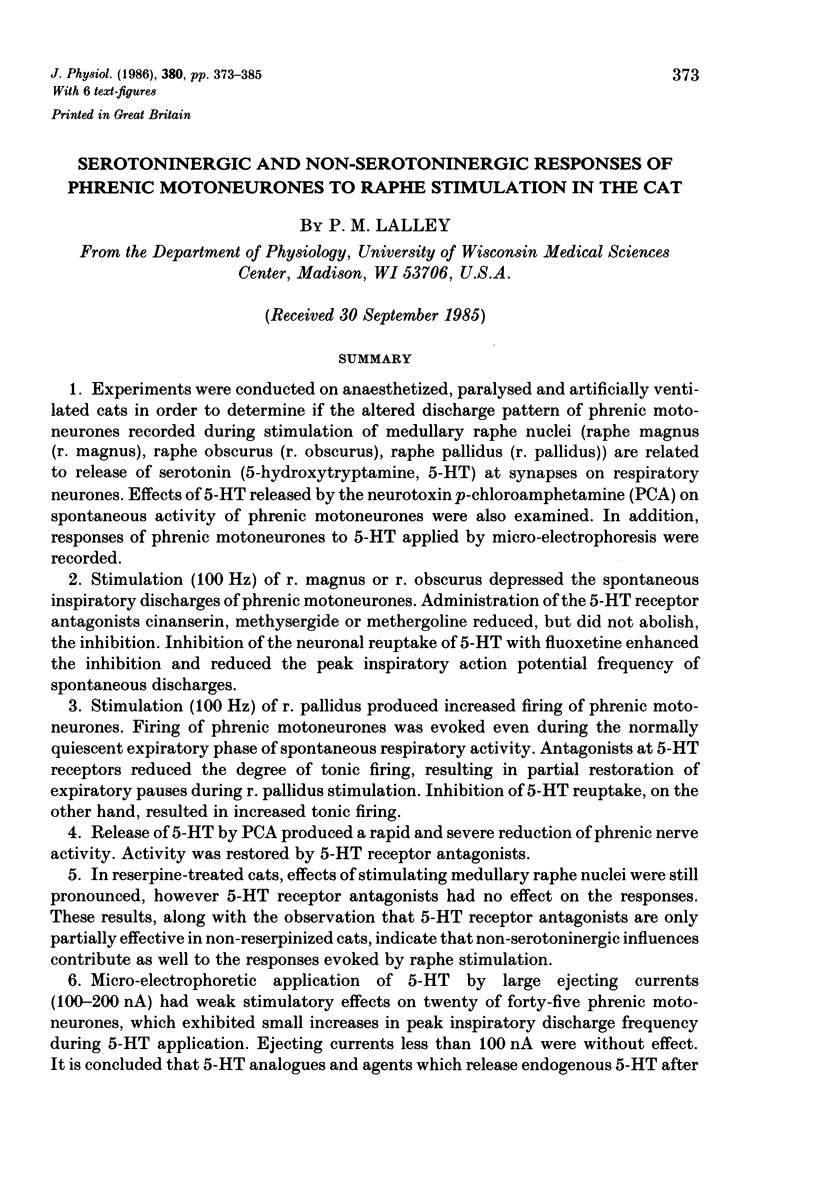






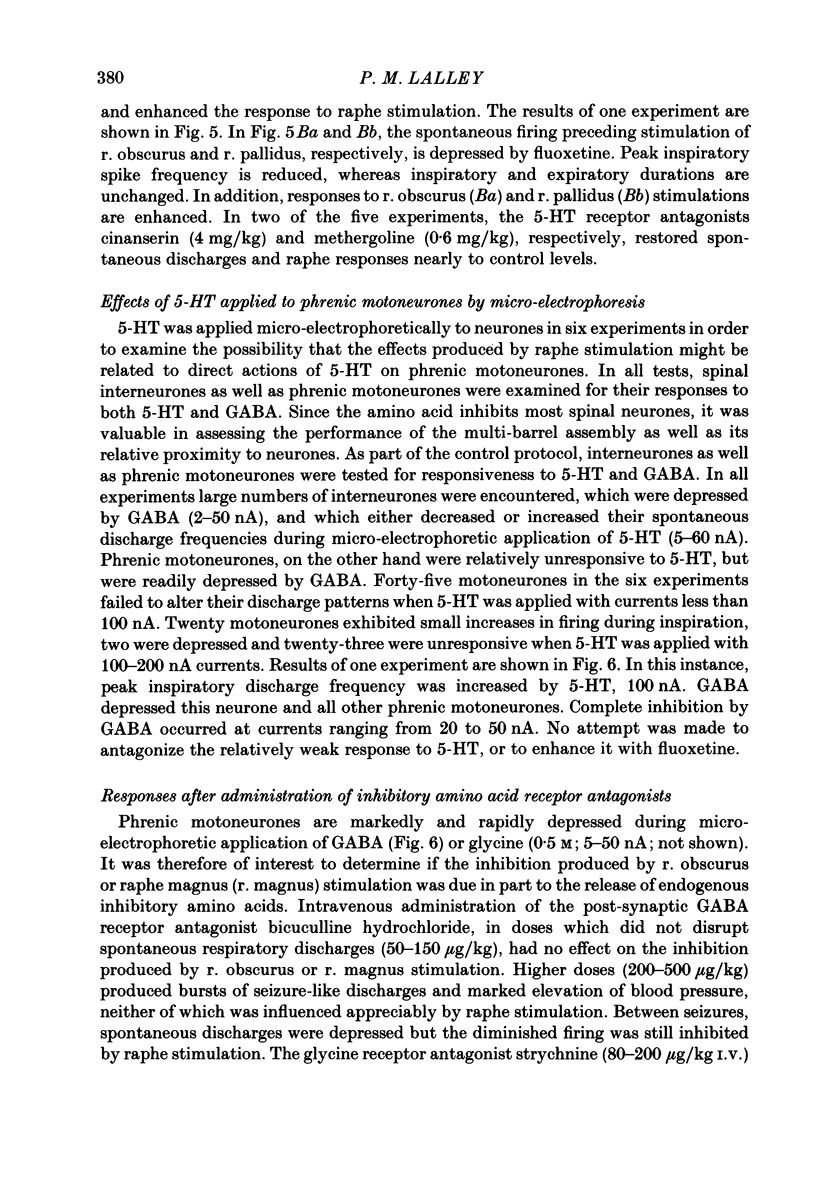
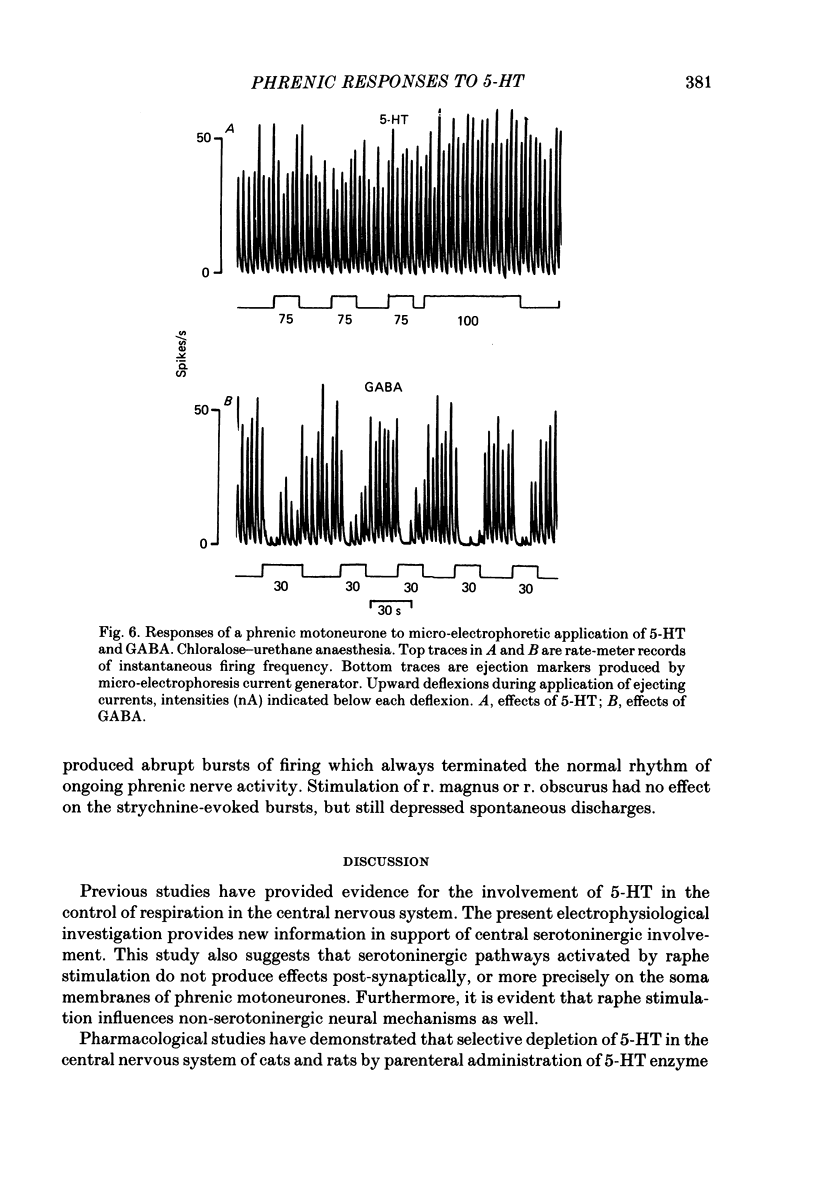

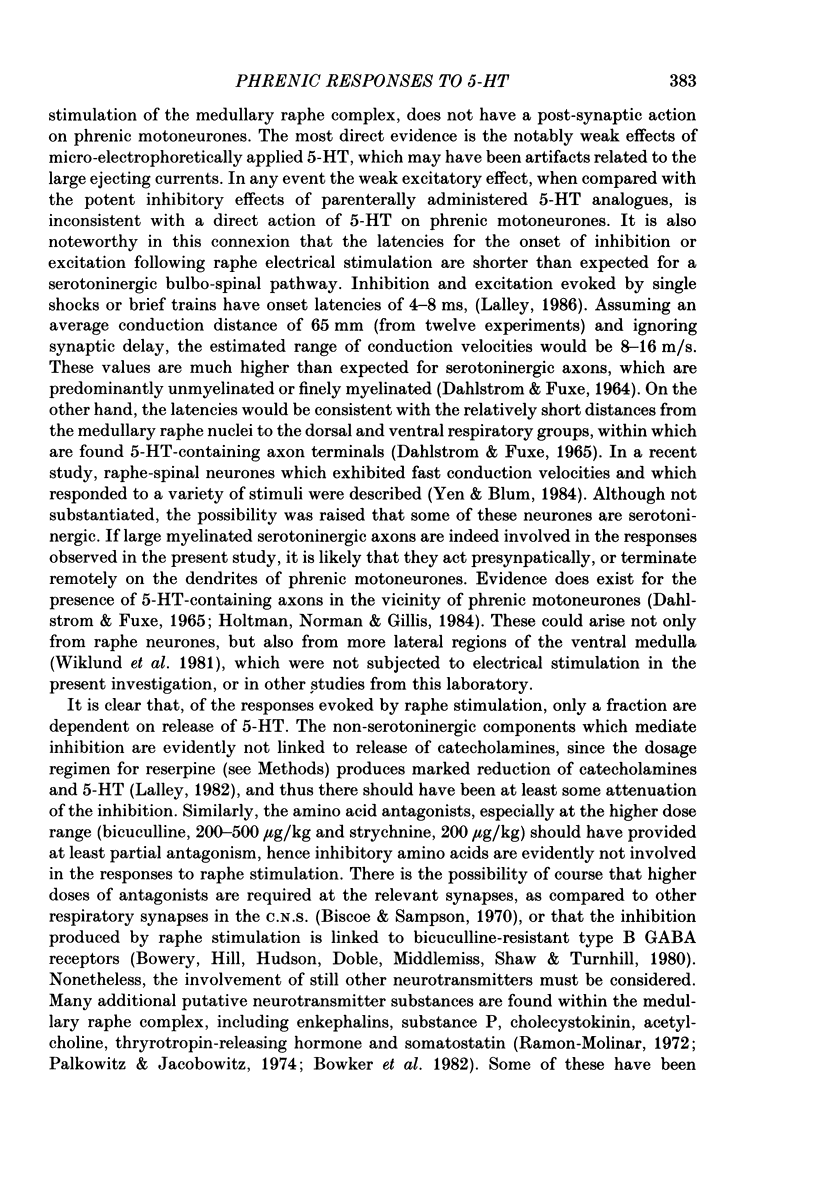

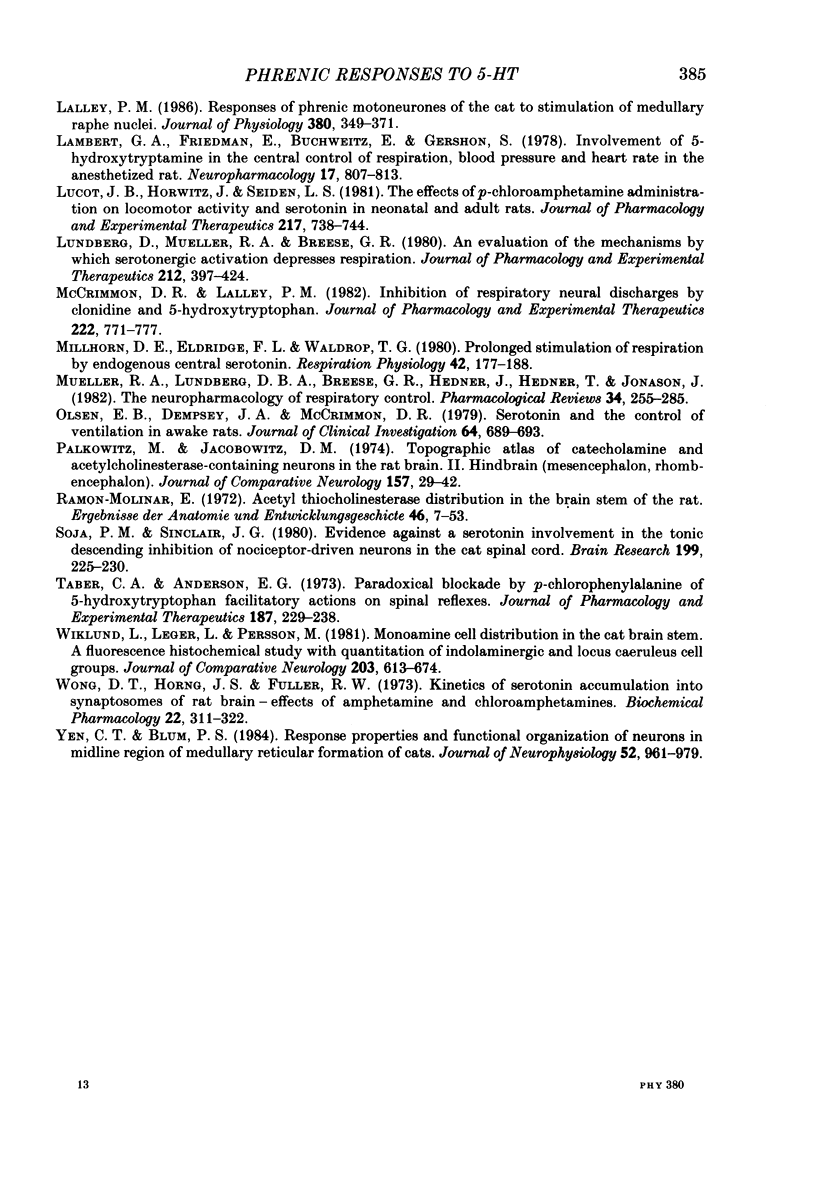
Images in this article
Selected References
These references are in PubMed. This may not be the complete list of references from this article.
- Armijo J. A., Flórez J. The influence of increased brain 5-hydroxytryptamine upon the respiratory activity of cats. Neuropharmacology. 1974 Nov;13(10-11):977–986. doi: 10.1016/0028-3908(74)90089-6. [DOI] [PubMed] [Google Scholar]
- Biscoe T. J., Sampson S. R. An analysis of the inhibition of phrenic motoneurones which occurs on stimulation of some cranial nerve afferents. J Physiol. 1970 Aug;209(2):375–393. doi: 10.1113/jphysiol.1970.sp009170. [DOI] [PMC free article] [PubMed] [Google Scholar]
- Bowery N. G., Hill D. R., Hudson A. L., Doble A., Middlemiss D. N., Shaw J., Turnbull M. (-)Baclofen decreases neurotransmitter release in the mammalian CNS by an action at a novel GABA receptor. Nature. 1980 Jan 3;283(5742):92–94. doi: 10.1038/283092a0. [DOI] [PubMed] [Google Scholar]
- Bowker R. M., Westlund K. N., Sullivan M. C., Coulter J. D. Organization of descending serotonergic projections to the spinal cord. Prog Brain Res. 1982;57:239–265. doi: 10.1016/S0079-6123(08)64132-1. [DOI] [PubMed] [Google Scholar]
- Champagnat J., Denavit-Saubié M., Henry J. L., Leviel V. Catecholaminergic depressant effects on bulbar respiratory mechanisms. Brain Res. 1979 Jan 5;160(1):57–68. doi: 10.1016/0006-8993(79)90600-0. [DOI] [PubMed] [Google Scholar]
- Fallert M., Böhmer G., Dinse H. R., Sommer T. J., Bittner A. Microelectrophoretic application of putative neurotransmitters onto various types of bulbar respiratory neurons. Arch Ital Biol. 1979 Jan;117(1):1–12. [PubMed] [Google Scholar]
- Flórez J., Delgado G., Armijo J. A. Adrenergic and serotonergic mechanisms in morphine-induced respiratory depression. Psychopharmacologia. 1972;24(2):258–274. doi: 10.1007/BF00403646. [DOI] [PubMed] [Google Scholar]
- Fuller R. W. Functional consequences of inhibiting serotonin uptake with fluoxetine in rats. Adv Biochem Psychopharmacol. 1982;34:219–228. [PubMed] [Google Scholar]
- Holtman J. R., Jr, Norman W. P., Gillis R. A. Projections from the raphe nuclei to the phrenic motor nucleus in the cat. Neurosci Lett. 1984 Jan 27;44(1):105–111. doi: 10.1016/0304-3940(84)90229-5. [DOI] [PubMed] [Google Scholar]
- Jones R. S., Broadbent J. Differential effects of fluoxetine and zimelidine on the uptake of 5-hydroxytryptamine and tryptamine by cortical slices and on responses of cortical neurones to stimulation of the nucleus raphe medianus. Eur J Pharmacol. 1982 Jul 30;81(4):681–685. doi: 10.1016/0014-2999(82)90361-2. [DOI] [PubMed] [Google Scholar]
- Lalley P. M. Inhibition of phrenic and sympathetic vasomotor neurons in cats by the serotonin analog 5-methoxy-N,N-dimethyltryptamine. J Pharmacol Exp Ther. 1982 Jan;220(1):39–48. [PubMed] [Google Scholar]
- Lalley P. M. Responses of phrenic motoneurones of the cat to stimulation of medullary raphe nuclei. J Physiol. 1986 Nov;380:349–371. doi: 10.1113/jphysiol.1986.sp016290. [DOI] [PMC free article] [PubMed] [Google Scholar]
- Lambert G. A., Friedman E., Buchweitz E., Gershon S. Involvement of 5-hydroxytryptamine in the central control of respiration, blood pressure and heart rate in the anaesthetized rat. Neuropharmacology. 1978 Oct;17(10):807–813. doi: 10.1016/0028-3908(78)90068-0. [DOI] [PubMed] [Google Scholar]
- Lucot J. B., Horwitz J., Seiden L. S. The effects of p-chloroamphetamine administration on locomotor activity and serotonin in neonatal and adult rats. J Pharmacol Exp Ther. 1981 Jun;217(3):738–744. [PubMed] [Google Scholar]
- Lundberg D. B., Mueller R. A., Breese G. R. An evaluation of the mechanism by which serotonergic activation depresses respiration. J Pharmacol Exp Ther. 1980 Mar;212(3):397–404. [PubMed] [Google Scholar]
- McCrimmon D. R., Lalley P. M. Inhibition of respiratory neural discharges by clonidine and 5-hydroxytryptophan. J Pharmacol Exp Ther. 1982 Sep;222(3):771–777. [PubMed] [Google Scholar]
- Millhorn D. E., Eldridge F. L., Waldrop T. G. Prolonged stimulation of respiration by endogenous central serotonin. Respir Physiol. 1980 Dec;42(3):171–188. doi: 10.1016/0034-5687(80)90113-9. [DOI] [PubMed] [Google Scholar]
- Mueller R. A., Lundberg D. B., Breese G. R., Hedner J., Hedner T., Jonason J. The neuropharmacology of respiratory control. Pharmacol Rev. 1982 Sep;34(3):255–285. [PubMed] [Google Scholar]
- Olson E. B., Jr, Dempsey J. A., McCrimmon D. R. Serotonin and the control of ventilation in awake rats. J Clin Invest. 1979 Aug;64(2):689–693. doi: 10.1172/JCI109510. [DOI] [PMC free article] [PubMed] [Google Scholar]
- Palkovits M., Jacobowitz D. M. Topographic atlas of catecholamine and acetylcholinesterase-containing neurons in the rat brain. II. Hindbrain (mesencephalon, rhombencephalon). J Comp Neurol. 1974 Sep 1;157(1):29–42. doi: 10.1002/cne.901570104. [DOI] [PubMed] [Google Scholar]
- Ramon-Moliner E. Acetylthiocholinesterase distribution in the brain stem of the cat. Ergeb Anat Entwicklungsgesch. 1972;46(4):7–53. doi: 10.1007/978-3-642-50055-8. [DOI] [PubMed] [Google Scholar]
- Soja P. J., Sinclair J. G. Evidence against a serotonin involvement in the tonic descending inhibition of nociceptor-driven neurons in the cat spinal cord. Brain Res. 1980 Oct 13;199(1):225–230. doi: 10.1016/0006-8993(80)90244-9. [DOI] [PubMed] [Google Scholar]
- Taber C. A., Anderson E. G. Paradoxical blockade by p-chlorophenylalanine of 5-hydroxytryptophan facilitatory actions on spinal reflexes. J Pharmacol Exp Ther. 1973 Nov;187(2):229–238. [PubMed] [Google Scholar]
- Wiklund L., Léger L., Persson M. Monoamine cell distribution in the cat brain stem. A fluorescence histochemical study with quantification of indolaminergic and locus coeruleus cell groups. J Comp Neurol. 1981 Dec 20;203(4):613–647. doi: 10.1002/cne.902030405. [DOI] [PubMed] [Google Scholar]
- Wong D. T., Horng J. S., Fuller R. W. Kinetics of serotonin accumulation into synaptosomes of rat brain--effects of amphetamine and chloroamphetamines. Biochem Pharmacol. 1973 Feb 1;22(3):311–322. doi: 10.1016/0006-2952(73)90412-7. [DOI] [PubMed] [Google Scholar]
- Yen C. T., Blum P. S. Response properties and functional organization of neurons in midline region of medullary reticular formation of cats. J Neurophysiol. 1984 Nov;52(5):961–979. doi: 10.1152/jn.1984.52.5.961. [DOI] [PubMed] [Google Scholar]




